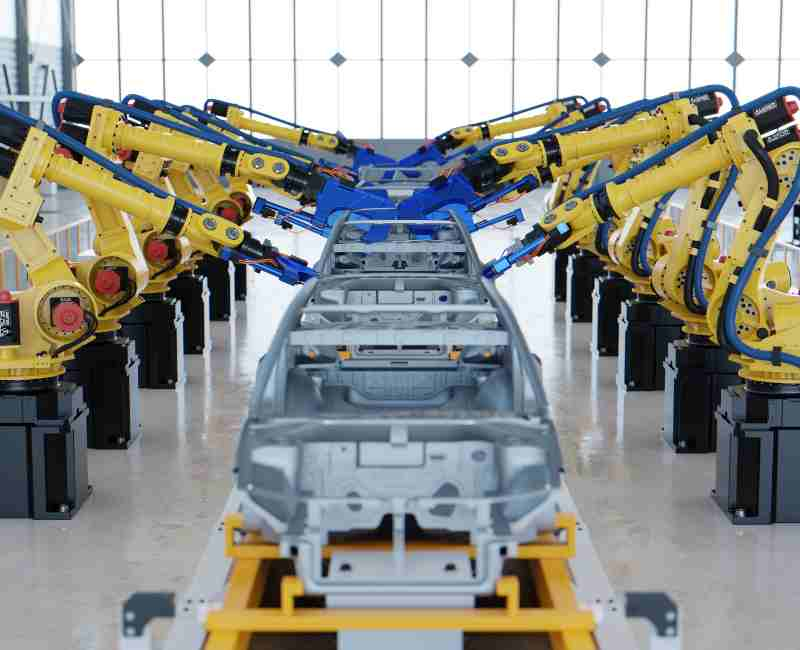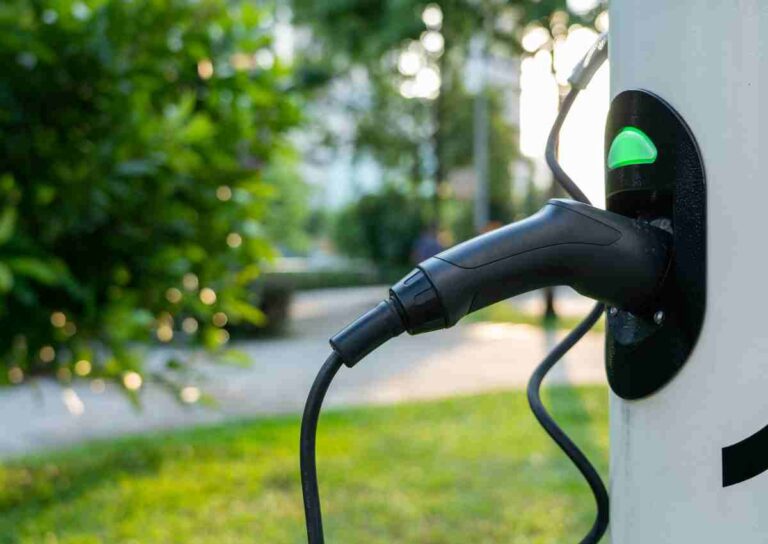The automotive industry stands at a pivotal crossroads, where the path to sustainability intersects with technological innovation. This juncture, driven by an urgent need to address climate change and environmental concerns, has given rise to what is widely recognized as the Green Revolution in the automotive sector. This revolution is not just a fleeting trend; it’s a comprehensive overhaul of how we think about, manufacture, and use vehicles.

Current State of the Automotive Industry:
-
- The industry, historically reliant on fossil fuels, is undergoing a transformative shift.
- Electric vehicles (EVs) have surged in popularity, marking a significant move away from traditional gasoline-powered cars.
- Car manufacturers globally are investing heavily in the research and development of sustainable technologies.
- Consumer demand for eco-friendly options is at an all-time high, influencing market trends and corporate strategies.
The Green Revolution in Automotive:
-
- This revolution is characterized by a significant shift towards sustainable practices and eco-friendly innovations.
- Electric cars and hybrid vehicles are at the forefront of this change, with advancements in battery technology and electric mobility.
- The revolution is not limited to just products (cars) but also encompasses changes in production methods, supply chain management, and business models.
Significance of Sustainable Practices and Innovations:
-
- Sustainable practices in the automotive industry are vital for reducing the environmental impact of transportation.
- Innovations in hybrid technology and renewable energy sources for vehicles are contributing to a more sustainable future.
- The shift is also propelled by increasing government regulations worldwide, aimed at reducing emissions and promoting green technology.
Vehicles and Technology
The landscape of the automotive industry is being reshaped by the advent of green technology. This evolution is marked by significant strides in electric vehicles (EVs), hybrid technology, and eco-friendly vehicle design. These advancements are not just redefining the capabilities of vehicles but also paving the way for a more sustainable future in transportation.
Evolution of Green Technology in Cars
Development of Electric Vehicles (EVs):
-
- Rise of Electric Cars: The last few years have witnessed a remarkable surge in the popularity and adoption of electric cars. This is a direct response to the growing awareness of environmental issues and the need for cleaner transportation solutions.
- Advancements in Battery-Electric Vehicles: One of the most significant developments in EVs has been in battery technology. The progress in energy density, charging speed, and battery lifespan has significantly improved the practicality and appeal of electric cars.
- Market Expansion: From luxury models to more affordable options, the market for electric cars is expanding rapidly, making them accessible to a broader consumer base.
Advancements in Hybrid Technology:
-
- Hybrid Vehicles and the Future: Hybrid vehicles, which combine a gasoline engine with an electric motor, are playing a crucial role in the transition to greener transportation. They offer a practical solution for reducing emissions while addressing the range anxiety associated with fully electric vehicles.
- Innovation in Hybrid Systems: Modern hybrids come in various forms, including mild-hybrid, full-hybrid, and plug-in hybrids, each offering different levels of fuel efficiency and emission reduction.
- Consumer Acceptance: Hybrids have gained significant market acceptance as they provide a balance between traditional fuel-based cars and EVs, serving as a stepping stone towards a fully electrified future.
Emerging Trends in Eco-Friendly Vehicle Design:
-
- New Players in the Automotive Revolution: The green technology wave has ushered in new players in the automotive industry, ranging from startups focusing on electric mobility to established manufacturers embracing energy efficiency.
- Design Innovations: Beyond just the powertrain, significant innovations are seen in vehicle design, focusing on aerodynamics, lightweight materials, and energy-efficient accessories.
- Focus on Electric Mobility and Energy Efficiency: The industry is witnessing a holistic approach to eco-friendly designs where every aspect of the vehicle is optimized for minimal environmental impact.
- More Post: Energy-Efficient Cooling Solutions for Data Centers
Emissions and Environmental Impact
The automotive industry has long been associated with environmental concerns, primarily due to the emissions produced by traditional fuel sources. In recent years, there has been a concerted effort to address these issues and mitigate the environmental impact of the industry through the adoption of green technology and adherence to stringent government regulations.
Impact of Traditional Fuel Emissions
Environmental Consequences of Fossil Fuels:
-
- Air Pollution: The combustion of fossil fuels, especially in gasoline-powered cars, releases pollutants into the air, contributing to smog, respiratory issues, and overall air quality degradation.
- Greenhouse Gas Emissions: Fossil fuel combustion is a major source of greenhouse gases like carbon dioxide (CO2), contributing significantly to global warming and climate change.
- Resource Depletion: Extracting and using fossil fuels depletes finite natural resources and poses environmental risks during extraction and transportation.
Role of Green Technology in Reducing Carbon Footprint:
-
- Electrified Vehicles as a Sustainable Solution: The widespread adoption of electric vehicles (EVs) has emerged as a viable solution to reduce the carbon footprint of transportation.
- Renewable Energy Sources: Charging EVs with energy from renewable sources, such as solar or wind, further diminishes their environmental impact by eliminating reliance on fossil fuels.
- Lifecycle Emissions Comparison: Studies show that, over their entire lifecycle, electric vehicles can have significantly lower emissions compared to traditional internal combustion engine vehicles.
Government Regulations and Emission Targets
Legislation Driving Change:
-
- European Union (EU) Initiatives: The EU has been at the forefront of implementing policies and regulations aimed at reducing emissions from vehicles. Stringent emission standards and targets are set to encourage the adoption of greener technologies.
- United States Regulations: In the U.S., federal and state-level regulations mandate the reduction of emissions from vehicles. Initiatives like the Corporate Average Fuel Economy (CAFE) standards promote fuel efficiency and emission reduction.
Promoting Low-Carbon Transportation:
-
- Incentives for Green Vehicles: Governments are offering incentives and subsidies to consumers and manufacturers to promote the purchase and production of low-carbon and zero-emission vehicles.
- Penalties for Non-Compliance: Regulatory bodies impose penalties on manufacturers that fail to meet emission standards, encouraging the industry to invest in cleaner technologies.
Global Cooperation Against Climate Change:
-
- International Agreements: The automotive industry is part of a broader global effort to combat climate change. International agreements and commitments seek to align countries and industries in reducing emissions and transitioning to sustainable practices.
Mobility and Future Trends
The future of automotive mobility is being shaped by rapid advancements in technology and a growing emphasis on sustainability. This evolution is not only about the vehicles we drive but also about how they integrate with broader societal and environmental needs. From autonomous and connected vehicles to sustainable mobility solutions, the automotive landscape is undergoing a revolutionary change, driven by shifting consumer preferences and a heightened demand for eco-friendly options.
Autonomous and Connected Vehicles
Integration of Autonomous Vehicles and IoT:
-
- Autonomous Technology: Self-driving cars are poised to redefine the norms of transportation. Integrating advanced sensors, AI, and machine learning, these vehicles promise to enhance safety and efficiency.
- IoT Devices and Connectivity: The Internet of Things (IoT) plays a crucial role in this transformation, enabling vehicles to communicate with each other and with infrastructure, leading to smarter, more efficient transportation systems.
Eco-friendly Transportation and Autonomous Vehicles:
-
- Reducing Emissions through Efficiency: Autonomous vehicles can potentially reduce emissions by optimizing driving patterns and reducing traffic congestion.
- Integration with Electric Mobility: The synergy between autonomous technology and electric vehicles (EVs) amplifies the environmental benefits, potentially leading to a significant reduction in the carbon footprint of transportation.
Sustainable Mobility Solutions
Role of Plug-in Hybrid Electric Vehicles (PHEVs):
-
- Bridging the Gap: PHEVs serve as an important transitional technology, offering the benefits of electrification while addressing the range anxiety associated with fully electric vehicles.
- Fuel Efficiency and Lower Emissions: By combining an internal combustion engine with an electric motor, PHEVs offer improved fuel efficiency and lower emissions compared to traditional vehicles.
Vehicle-to-Grid (V2G) Systems:
-
- Energy Management: V2G technology allows electric vehicles to interact with the power grid, providing the capability to store and supply electricity, enhancing overall energy efficiency.
- Balancing the Grid: V2G can play a crucial role in stabilizing the grid, especially as renewable energy sources, which can be intermittent, become more prevalent.
Changing Consumer Preferences and Demand for Eco-Friendly Options
Shift Towards Fully Electric Vehicles:
-
- Consumer Awareness and Preferences: Growing environmental awareness among consumers is driving a marked shift towards fully electric vehicles.
- Market Trends: Automakers are responding to this demand by expanding their EV offerings, signaling a significant shift in the automotive market.
Sustainable Business Practices in the Automotive Industry:
-
- Corporate Responsibility: Manufacturers are increasingly adopting sustainable business practices, not just in vehicle production but across their operations, from supply chain management to end-of-life vehicle recycling.
- Impact on Brand Perception: Companies prioritizing sustainability are finding a competitive edge as consumers increasingly factor in environmental impact in their purchasing decisions.
Market shifts and Business
The automotive business landscape is undergoing significant transformations driven by the imperative for sustainability. This evolution is not just limited to the vehicles themselves but extends to how auto manufacturers and companies operate, produce, and respond to changing consumer demands.
Auto Manufacturers and Companies
Focus on Green Technology by Leading Car Manufacturers:
-
- Jaguar Land Rover’s (JLR) Investment: Prominent car manufacturers, such as Jaguar Land Rover (JLR), are making substantial investments in green technology. JLR’s commitment to electric mobility and sustainability is exemplified through its production of electric and plug-in hybrid vehicles.
- Industry-wide Initiatives: JLR’s efforts are part of a broader industry trend where major manufacturers are recognizing the importance of embracing green technology to stay competitive and meet evolving consumer expectations.
Innovation in Vehicle Offerings:
-
- Expanding Electric Vehicle Lineup: Auto manufacturers are expanding their electric vehicle (EV) offerings, introducing a diverse range of models to cater to different market segments.
- Hybrid and electric SUVs: There is a notable focus on the production of hybrid and electric SUVs, aligning with consumer preferences for larger vehicles while still prioritizing sustainability.
Production and Supply Chain Changes
Adapting Supply Chains for Electric Vehicle Production:
-
- Battery Production: The shift towards electric vehicles necessitates a focus on advanced battery technologies. Auto manufacturers are investing in or partnering with battery manufacturers to secure a stable supply of high-performance batteries.
- Raw Material Procurement: Ensuring a sustainable supply chain involves responsible sourcing of raw materials for battery production, with an emphasis on ethical mining practices and recycling initiatives.
Strategic Partnerships and Alliances:
-
- Collaboration for Sustainability: Automotive companies are forming strategic alliances and partnerships with suppliers, technology firms, and energy companies to create a sustainable ecosystem.
- Supply Chain Resilience: The restructuring of supply chains is not only driven by environmental concerns but also by a desire for increased resilience, especially in the wake of global disruptions like the recent pandemic.
Consumer Response to Green Initiatives
Shift in Consumer Preferences:
-
- Environmental Awareness: Consumers are becoming increasingly environmentally conscious, influencing their purchasing decisions. The rising awareness of climate change and its environmental impact is propelling a significant shift in consumer preferences.
- Preference for Sustainable Brands: Automotive companies that are proactive in adopting green initiatives are gaining favor among consumers, contributing to a changing market landscape.
Demand for Sustainable Features:
-
- Eco-Friendly Features: Consumers are actively seeking vehicles with eco-friendly features, such as energy-efficient systems, sustainable materials in interiors, and reduced emissions.
- Corporate Social Responsibility (CSR) Impact: Companies demonstrating a commitment to sustainability and CSR initiatives see a positive impact on their brand image, which, in turn, influences consumer choices.
- More Post: Carbon Footprint of E-Waste
- More Post: How Tech Giants are Going Environmentally Friendly (Green Data Centers)
Energy Sources and Fuel
The transition to sustainable energy in transportation is a cornerstone of the green revolution in the automotive industry. This shift is primarily focused on moving away from fossil fuels towards more sustainable, eco-friendly energy sources. Key areas include advancements in battery technology, the exploration of hydrogen fuel cells, and innovations in alternative fuel sources.
Battery Technology and Electric Power
Advancements in Battery Technology:
-
- Development for Electric Vehicles (EVs): Battery technology is critical in the development of EVs. Recent years have seen significant improvements in battery life, energy density, charging speed, and overall efficiency.
- Contribution to the Green Economy: The rise of EVs, powered by advanced batteries, is a significant contributor to the green economy, reducing reliance on fossil fuels and cutting emissions.
Challenges and Innovations:
-
- Battery Cost and Lifespan: Despite advancements, challenges such as high costs and concerns over battery lifespan and recycling continue to be areas of focus.
- Sustainable Battery Materials: Research is being directed towards more sustainable materials for batteries, aiming to reduce environmental impact and improve recyclability.
The Role of Hydrogen Fuel Cells
Hydrogen as a Renewable Energy Source:
-
- Basics of Hydrogen Fuel Cells: Hydrogen fuel cells generate electricity through a chemical reaction between hydrogen and oxygen, with water being the only byproduct.
- Potential in the Automotive Industry: Hydrogen fuel cells are viewed as a promising alternative, especially for larger vehicles and those requiring longer range, due to their quick refueling time and high energy density.
Challenges and Opportunities:
-
- Infrastructure and Production: The main challenges for hydrogen fuel cells include the development of hydrogen production and refueling infrastructure.
- Environmental Impact: While hydrogen is clean at the point of use, its production is currently reliant on fossil fuels, though efforts are underway to shift to renewable energy sources.
Innovations in Alternative Fuel Sources
Emergence of New Energy Sources:
-
- Hydrogen Power: Beyond fuel cells, hydrogen is also being explored for its potential in internal combustion engines, offering a cleaner alternative to traditional fuels.
- Renewable Energy Integration: The integration of vehicles with renewable energy sources, like solar and wind power, is an area of ongoing research and development.
The Future of Automotive Energy:
-
- Diverse Energy Mix: The future automotive sector is likely to rely on a mix of energy sources, including electricity, hydrogen, and other renewable fuels, to meet various needs and applications.
- Investment in Research and Development: Continuous investment in R&D is essential to advance these technologies and make them viable for widespread use in the automotive industry.
Sustainability and Materials
In the context of the Green Revolution in the automotive industry, a pivotal aspect is the advancements in sustainable materials and manufacturing. This involves not only rethinking the materials used in vehicle production but also transforming the entire supply chain and manufacturing process to align with principles of sustainability and circular economy.
Sustainable Supply Chain Practices
Transformation Towards Sustainability:
-
- Ethical Sourcing of Materials: A focus on responsibly sourcing materials ensures that the procurement process is environmentally friendly and socially responsible.
- Supplier Selection and Collaboration: Automotive companies are increasingly selecting suppliers based on their sustainability practices and collaborating with them to improve overall environmental performance.
Supply chain optimization:
-
- Reducing Carbon Footprint: Implementing strategies to reduce the carbon footprint of supply chain activities, such as optimizing logistics to minimize transportation emissions,.
- Use of Renewable Energy: Encouraging suppliers to use renewable energy sources in their manufacturing processes.
Innovative Materials for Eco-Friendly Vehicles
Exploration of Sustainable Materials:
-
- Recycled and Bio-Based Materials: Use of recycled plastics, bio-based materials, and natural fibers in vehicle interiors and exteriors.
- Lightweight Materials: Adoption of lightweight materials like aluminum and carbon fiber, which improve fuel efficiency by reducing vehicle weight,.
Impact on Vehicle Production:
-
- Reducing Environmental Impact: By using more sustainable materials, the overall environmental impact of vehicle production is significantly reduced.
- Lifecycle Analysis: Emphasis on lifecycle analysis to ensure materials are not only eco-friendly in production but throughout the vehicle’s life.
Circular Economy in Automotive Production
Closed-Loop System Concept:
-
- Reusability and Recycling: Emphasizing the importance of designing vehicles and components with reusability and recyclability in mind from the outset.
- Extending Product Life: Implementing strategies for extending the life of automotive components and vehicles, such as refurbishing and remanufacturing,.
Benefits and Challenges:
-
- Reducing Waste and Resource Use: A circular economy approach significantly reduces waste and conserves natural resources.
- Economic and Environmental Benefits: While it presents certain challenges in implementation, this approach can lead to both economic and environmental benefits for the industry.
Government Initiatives and Impact
The role of governments in driving the green revolution in the automotive industry is crucial. Policies, incentives, and global efforts to address climate change through automotive regulations are shaping the industry’s trajectory towards sustainability and eco-friendly practices.
Policies Supporting Sustainable Transportation
Focus on Electric Vehicles (EVs):
-
- European Union (EU) Initiatives: The EU has been at the forefront of promoting sustainable transportation, with robust policies favoring the adoption of electric vehicles. Stricter emission standards and targets encourage the automotive industry to produce greener vehicles.
- United States Regulations: In the U.S., government initiatives aim to reduce the environmental impact of transportation through policies such as fuel economy standards and emissions regulations.
Investment in Charging Infrastructure:
-
- Development of Charging Stations: Governments are investing in the expansion of charging infrastructure to alleviate range anxiety and encourage the widespread adoption of electric vehicles.
- Incentives for Private Sector Participation: Governments are providing incentives for private companies to invest in and build electric vehicle charging networks.
Support for Research and Development:
-
- Grants and Funding: Governments are offering grants and funding for research and development in green technologies, encouraging innovation in areas such as battery technology and energy-efficient vehicle design.
- Collaboration with Industry: Partnerships between governments and the automotive industry are fostering innovation and accelerating the transition to sustainable transportation.
Incentives for Manufacturers and Consumers
Financial Incentives for Manufacturers:
-
- Tax Credits and Subsidies: Governments are offering tax credits and subsidies to auto manufacturers producing electric vehicles and adopting sustainable practices in their production processes.
- Research and Development Grants: Incentives for manufacturers extend to research and development activities focused on improving sustainability and reducing the environmental impact of automotive operations.
Consumer Incentives for Adoption:
-
- Purchase Incentives: Governments provide financial incentives to consumers purchasing electric vehicles, such as rebates, tax credits, and reduced registration fees.
- Access to HOV Lanes: Additional perks, such as access to high-occupancy vehicle (HOV) lanes, are granted to electric vehicle owners, encouraging the uptake of eco-friendly transportation options.
Regulatory Credits and Compliance Flexibility:
-
- Credit Systems: Governments implement credit systems where auto manufacturers earn credits for producing low-emission vehicles, promoting compliance with environmental regulations.
- Flexibility in Compliance: Some regulatory frameworks offer flexibility, allowing manufacturers to comply with emission standards through a combination of fuel-efficient vehicles, electric vehicles, and other green technologies.
Global Efforts to Address Climate Change Through Automotive Regulations
United Nations Framework Convention on Climate Change (UNFCCC):
-
- COP26 Commitments: Global initiatives, such as the Conference of the Parties (COP) meetings, bring nations together to discuss and commit to strategies for reducing greenhouse gas emissions, including those from the automotive sector.
- Shared Goals: Countries worldwide are setting shared goals to decarbonize transportation as part of broader efforts to mitigate climate change.
International Collaboration and Agreements:
-
- Paris Agreement: The Paris Agreement, signed by numerous countries, emphasizes the need to limit global warming and encourages the automotive industry to transition towards zero-emission vehicles.
- Harmonization of Standards: Efforts are underway to harmonize emission standards and testing procedures globally, ensuring consistency in regulations and facilitating the international adoption of sustainable practices.
Regional Collaborations for Emission Reduction:
-
- Collaboration in North America and Europe: Regional collaborations, such as agreements between North American and European countries, aim to align emission reduction targets and promote sustainable transportation practices.
- Sharing Best Practices: Countries are sharing best practices and experiences to accelerate the implementation of effective regulations and policies.
Adoption and Consumer Behavior
Understanding consumer perspectives on green automotive technologies is crucial to shaping the future of the automotive industry. The adoption of eco-friendly vehicles hinges not only on technological advancements and government policies but also significantly on consumer behavior and preferences.
Factors Influencing Consumer Choices
Adaptation to the Automotive Revolution:
-
- Awareness of Environmental Impact: Consumers are increasingly aware of the environmental impact of their choices, including the carbon footprint of their vehicles.
- Economic Considerations: Factors like fuel costs, maintenance expenses, and resale value play a significant role in consumer decision-making.
Availability of Electric SUVs and Hybrid Cars:
-
- Diverse Options: The availability of a wide range of electric SUVs and hybrid cars caters to varying consumer needs and preferences.
- Performance and Design: Consumers are considering aspects like vehicle performance, design, and technological features in their purchasing decisions.
Perceived Benefits and Drawbacks:
-
- Benefits: Consumers are influenced by the perceived benefits of electric and hybrid vehicles, such as lower running costs and reduced emissions.
- Drawbacks: Concerns about range, charging infrastructure, and initial costs can affect consumer choices.
Challenges in Widespread Adoption
Range Anxiety and Charging Infrastructure:
-
- Concerns about Range: One of the primary barriers to adoption is the limited range of electric vehicles compared to traditional gasoline-powered cars.
- Charging Infrastructure: The lack of widespread and accessible charging stations is a significant hurdle for many potential EV buyers.
Cost Considerations:
-
- High Initial Investment: The higher upfront cost of electric and hybrid vehicles compared to conventional cars can be a deterrent for consumers.
- Economic Incentives: Lack of sufficient economic incentives, such as tax rebates or subsidies, can slow down the adoption rate.
Consumer Misconceptions:
-
- Lack of Information: Misconceptions and a lack of information about the performance and maintenance of green vehicles can hinder adoption.
- Skepticism about New Technologies: Some consumers may be skeptical about the reliability and longevity of new automotive technologies.
Educating Consumers about the Benefits of Green Vehicles
Awareness campaigns and information dissemination:
-
- Role of Manufacturers and Governments: Both automotive manufacturers and governments play a key role in educating the public about the benefits of green vehicles.
- Use of Media and Advertising: Utilizing various media platforms to disseminate information and positive messaging about the benefits of eco-friendly transportation.
Real-life Testimonials and Experiences:
-
- Sharing User Experiences: Testimonials and real-life experiences from current users of electric and hybrid vehicles can positively influence potential buyers.
- Demonstrations and Test Drives: Offering opportunities for consumers to experience green vehicles firsthand through test drives and demonstrations.
Focusing on Long-Term Benefits:
-
- Environmental Impact: Emphasizing the long-term environmental benefits, such as reduced emissions and lower dependency on fossil fuels.
- Economic Savings: Highlighting the long-term economic savings in terms of fuel costs and maintenance.
Key Takeaways
- Widespread Adoption: The automotive industry is experiencing a significant shift towards electric vehicles, driven by advancements in battery technology and increasing consumer demand for sustainable transportation options.
- Diverse Offerings: Auto manufacturers are diversifying their electric vehicle lineup, offering a range of models from compact cars to electric SUVs, catering to various consumer preferences.
- Transition to Sustainable Energy: The adoption of renewable energy sources, such as solar and wind power, is becoming integral to the automotive industry’s efforts to reduce its carbon footprint.
- Hydrogen Fuel Cells: The exploration of hydrogen fuel cells as a renewable energy source further contributes to the industry’s commitment to cleaner energy solutions.
- Supply Chain Transformation: The industry is actively transforming its supply chain towards sustainability, emphasizing ethical sourcing, reducing emissions, and optimizing production processes.
- Innovations in Materials: The use of innovative and sustainable materials in vehicle production is becoming more prevalent, aligning with the principles of a circular economy.
Conclusion
In conclusion, the Green Revolution in the automotive industry signifies a paradigm shift towards sustainability, innovation, and a greener future in transportation. The adoption of electric vehicles, the integration of renewable energy sources, and the emphasis on sustainable practices across the supply chain highlight the industry’s commitment to mitigating its environmental impact. As consumers increasingly prioritize eco-friendly options, continued innovation and collaboration between industry stakeholders, governments, and consumers are essential to propel the automotive sector towards a more sustainable and environmentally conscious future. The journey towards greener transportation is not just a trend but a fundamental transformation that demands ongoing commitment and innovation from all participants in the automotive ecosystem.






